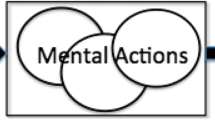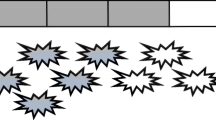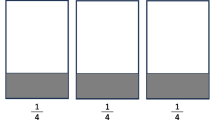Abstract
Research shows that students, and sometimes teachers, have trouble with fractions, especially conceiving of fractions as numbers that extend the whole number system. This paper explores how fractions are addressed in undergraduate mathematics courses for prospective elementary teachers (PSTs). In particular, we explore how, and whether, the instructors of these courses address fractions as an extension of the whole number system and fractions as numbers in their classrooms. Using a framework consisting of four approaches to the development of fractions found in history, we analyze fraction lessons videotaped in six mathematics classes for PSTs. Historically, the first two approaches—part–whole and measurement—focus on fractions as parts of wholes rather than numbers, and the last two approaches—division and set theory—formalize fractions as numbers. Our results show that the instructors only implicitly addressed fraction-as-number and the extension of fractions from whole numbers, although most of them mentioned or emphasized these aspects of fractions during interviews.












Similar content being viewed by others
Notes
This development was preceded by many centuries of work by mathematicians who struggled with the notation for fractions and with developing algorithms for operations with fractions. Attempts to integrate fractions into the number system finally led to the formalization of decimal fractions by Stevin in the seventeenth century (Smith, 1925).
A divisible remainder occurs when an object can be divided, for example, a candy bar. An indivisible remainder refers to an object that cannot be divided like a school bus or a person. That is, a result can include half a candy bar, but not half a person.
References
Austin, D. (2007). Pulling digits out of pi. Feature column: Montly Essays on Mathematical Topics. http://www.ams.org/samplings/feature-column/fcarc-pi. Accessed 18 Sept 2010
Ball, D. (1988). Knowledge and reasoning in mathematical pedagogy: examining what prospective teachers bring to teacher education. Unpublished dissertation, Michigan State University, East Lansing.
Ball, D. L. (1990). The mathematical understandings that prospective teachers bring to teacher education. The Elementary School Journal, 90(4), 449–466.
Baumgart, J. K. (1969). Historical topics for the mathematics classroom. Reston, VA: National Council of Teachers of Mathematics.
Beckmann, S. (2005). Mathematics for elementary teachers. Boston: Addison Wesley.
Beckmann, S. (2008). Mathematics for elementary teachers (2nd ed.). Boston, MA: Addison Wesley.
Behr, M., Harel, G., Post, T., & Lesh, R. (1993). Rational numbers: Toward a semantic analysis—emphasis on the operator construct. In T. Carpenter, E. Fennema, & T. Romberg (Eds.), Rational numbers: An integration of research (pp. 13–47). Hillsdale: Lawrence Erlbaum.
Berlinghoff, W. P., & Gouvea, F. Q. (2004). Math through the ages, Expanded edition. Washington, DC: Mathematical Association of America, Farmington, ME: Oxton House Publishers.
Cajori, F. (1928). A history of mathematical notation—Notations in elementary mathematics. Illinois: The Open Court Publishing Company.
Carpenter, T., Fennema, E., Franke, M. L., Levi, L., & Empson, S. B. (1999). Children’s mathematics: Cognitively guided instruction. Portsmouth: Heinemann.
Childs, L. (1995). A concrete introduction to higher algebra. New York: Springer.
Clark, K. M. (2011). History of mathematics: illuminating understanding of school mathematics concepts for prospective mathematics teachers. Educational Studies in Mathematics. http://www.springerlink.com/content/k5mv6814246755l5/. Accessed 26 Nov 2011
Dantzig, T. (1954). Number: The language of science. New York: Macmillan.
Dorier, J. (1998). The role of formalism in the teaching of the theory of vector spaces. Linear Algebra and Its Application, 275–276, 114–160.
Dorier, J., Robert, A., Robinet, J., & Rogalski, M. (2000). On a research programme concerning the teaching and learning of linear algebra in the first-year of a French science university. International Journal of Mathematical Education in Science and Technology, 31(1), 27–35.
Erlwanger, S. H. (1973). Benny’s conception of rules and answers in IPI mathematics. Journal of Children’s Mathematical Behavior, 1(2), 7–26. Reprinted in Carpenter, T. P., Dossey, J. A., & Koehler, J. L. (Eds.). (2004). Classics in mathematics education research. Reston, VA: National Council of Teachers of Mathematics.
Even, R. (2008). Facing the challenge of educating educators to work with practicing mathematics teachers. In B. Jaworski & T. Wood (Eds.), The international handbook of mathematics teacher education, vol 4. The mathematics teacher educator as a developing professional (Vol. 4, pp. 57–74). Rotterdam: Sense.
Fauvel, J., & van Maanen, J. (Eds.). (2000). History in mathematics education: The ICMI study. Dordrecht: Kluwer.
Fischbein, E., Jehiam, R., & Cohen, C. (1995). The concept of irrational number in high-school students and prospective teachers. Educational Studies in Mathematics, 29, 29–44.
Hart, K. (1987). Children’s mathematics frameworks: part 2. What are equivalent fractions? Mathematics in School, 16(4), 5–7.
Heath, T. L. (1956). The thirteen books of Euclid’s elements, vols. 1–3 (2nd ed.). New York: Dover.
Jankvist, J. T. (2009). A categorization of the “whys” and “hows” of using history in mathematics education. Educational Studies in Mathematics, 71, 235–261.
Kerslake, D. (1986). Fractions: Children’s strategies and errors. Windsor: NFER-Nelson.
Kieren, T. E. (1992). Rational and fractional numbers as mathematical and personal knowledge: Implications for curriculum and instruction. In G. Leinhardt, R. Putnam, & R. A. Hattrup (Eds.), Analysis of arithmetic for mathematics teaching (pp. 323–372). Hillsdale: Erlbaum.
Klein, J. (1968). Greek mathematical thought and the origin of algebra. Cambridge: M.I.T. Press.
Lamon, S. L. (2001). Presenting and representing: From fractions to rational numbers. In A. Cuoco & F. Curcio (Eds.), The roles of representations in school mathematics (2001), Yearbook, Reston: NCTM, (pp. 146–165).
Lamon, S. J. (2007). Rational numbers and proportional reasoning: Toward a theoretical framework for research. In F. K. Lester (Ed.), Second handbook of research on mathematics teaching and learning (2007), Information Age Publishing, Charlotte NC, (pp. 629–667).
Ma, L. (1998). Knowing and teaching elementary mathematics: Teachers’ understanding of fundamental mathematics in China and the United States. Mahwah: Lawrence Erlbaum.
Mack, N. K. (1990). Learning fractions with understanding: Building on informal knowledge. Journal for Research in Mathematics Education, 21(1), 16–32.
Mack, N. K. (1993). Learning rational numbers with understanding. The case of informal knowledge. In T. P. Carpenter, E. Fennema, & T. A. Romberg (Eds.), Rational numbers: An integration of research (pp. 85–105). Hillsdale: Lawrence Erlbaum.
Newton, K. J. (2008). An extensive analysis of elementary preservice teachers’ knowledge of fractions. American Educational Research Journal, 45(4), 1080–1110.
Osana, H. P., & Royea, D. A. (2011). Obstacles and challenges in preservice teachers’ explorations with fractions: A view from a small-scale intervention study. The Journal of Mathematical Behavior, 30, 333–352.
Parker, T. H., & Baldridge, S. J. (2003). Elementary mathematics for teachers. Okemos: Sefton-Ash Publishing.
Pitkethly, A., & Hunting, R. (1996). A review of recent research in the area of initial fraction concepts. Educational Studies in Mathematics, 30, 5–38.
Pogliani, L., Randic, M., & Trinajstic, N. (1998). Much ado about nothing—an introductory inquiry about zero. International Journal of Mathematical Education in Science and Technology, 29, 729–744.
Post, T. R., Harel, G., Behr, M. J., & Lesh, R. (1988). Intermediate teachers knowledge of rational number concepts. In E. Fennema, T. P. Carpenter, & S. J. Lamon (Eds.), Integrating research on teaching and learning mathematics (pp. 177–198). New York: State University of NY Press.
Post, T. R., Cramer, K. A., Lesh, R., Harel, G., & Behr, M. (1993). Curriculum implications of research on the learning, teaching and assessing of rational number concepts. In T. P. Carpenter, E. Fennema, & T. A. Romberg (Eds.), Rational numbers: An integration of research (pp. 327–362). Hillsdale: Lawrence Erlbaum Associates Publishers.
Radford, M. (1995). Before the other unknowns were invented: Didactic inquires on the method and programs of medieval Italian algebra. For the Learning of Mathematics, 15(3), 28–38.
Radford, M., Barolini-Bussi, M. G., Bekken, O., Boero, P., Dorier, J., Katz, V., Rogers, L., Sierpinska, A., & Vasco, C. (2002). Historical formation and student understanding of mathematics. New ICMI Study Series, 6, 143–170.
Rizvi, N. F., & Lawson, M. J. (2007). Prospective teachers’ knowledge: Concept of division. International Education Journal, 8(2), 377–392.
Seife, C. (2000). Zero, the biography of a dangerous idea. New York: Penguin.
Sfard, A. (1995). The development of algebra: Confronting historical and psychological perspectives. The Journal of Mathematical Behavior, 14, 15–39.
Smith, D. E. (1923). History of mathematics, volume I. New York: Dover.
Smith, D. E. (1925). History of mathematics, volume II. New York: Ginn & Company.
Sowder, J. T., Bedzuk, N., & Sowder, L. K. (1993). Using principles from cognitive psychology to guide rational number instruction for prospective teachers. In T. P. Carpenter, E. Fennema, & T. A. Romberg (Eds.), Rational numbers: An integration of research (pp. 239–259). Hillsdale: Lawrence Erlbaum.
Sowder, J., Philipp, R., Armstrong, B., & Schappelle, B. (1998). Middle-grade teachers’ mathematical knowledge and its relationship to instruction: A research monograph. Albany: State University of New York Press.
Stafylidou, S., & Vosniadou, S. (2004). The development of students’ understanding of the numerical value of fractions. Learning and Instruction, 14, 503–518.
Streefland, L. (1993). Fractions: A realistic approach. In T. P. Carpenter, E. Fennema, & T. A. Romberg (Eds.), Rational numbers: An integration of research (pp. 289–325). Hillsdale: Lawrence Erlbaum Associates Publishers.
Tirosh, D. (2000). Enhancing prospective teachers’ knowledge of children’s conceptions: The case of division of fractions. Journal for Research in Mathematics Education, 31(1), 5–25.
Tirosh, D., Fischbein, E., Graeber, A. O., & Wilson, J. W. (1999). Prospective elementary teachers’ conceptions of rational numbers. http://jwilson.coe.uga.edu/texts.folder/tirosh/pros.el.tchrs.html. Accessed 11 Jun 2004
Vamvakoussi, X., & Vosniadou, S. (2007). How many numbers are there in a rational number interval? Constraints, synthetic models and the effect of the number line. In S. Vosniadou, A. Baltas, & X. Vamvakoussi (Eds.), Reframing the conceptual change approach in learning and instruction (pp. 265–282). Amsterdam: Elsevier.
Weil, A. (1978). History of mathematics: Why and how. In Proceedings of the International Congress of Mathematicians, Helsinki (pp. 227–236) 1978. Helsinki: Academia Scientiarum Fennica.
Weller, K., Arnon, I., & Dubinsky, E. (2009). Preservice teachers’ understanding of the relation between a fraction or integer and its decimal expansion. Canadian Journal of Science, 9(1), 5–28.
Wilson, S., Floden, R. E., & Ferrini-Mundy, J. (2001). Teacher preparation research: Current knowledge, gaps, and recommendations. Seattle: Center for the Study of Teaching and Policy.
Wu, H. (2010). Learning school algebra in the U.S. In Y. Li & Z. Huan (Eds.), Mathematics education: Perspectives and practices in the East and West. Special Issue of Mathematics Bulletin (pp. 101–114). Beijing, China: Chinese Mathematical Society, Beijing Normal University.
Zhou, Z., Peverly, S. T., & Xin, T. (2006). Knowing and teaching fractions: A cross-cultural study of American and Chinese mathematics teachers. Comtemporary Educational Psychology, 31, 438–457.
Author information
Authors and Affiliations
Corresponding author
Rights and permissions
About this article
Cite this article
Park, J., Güçler, B. & McCrory, R. Teaching prospective teachers about fractions: historical and pedagogical perspectives. Educ Stud Math 82, 455–479 (2013). https://doi.org/10.1007/s10649-012-9440-8
Published:
Issue Date:
DOI: https://doi.org/10.1007/s10649-012-9440-8




